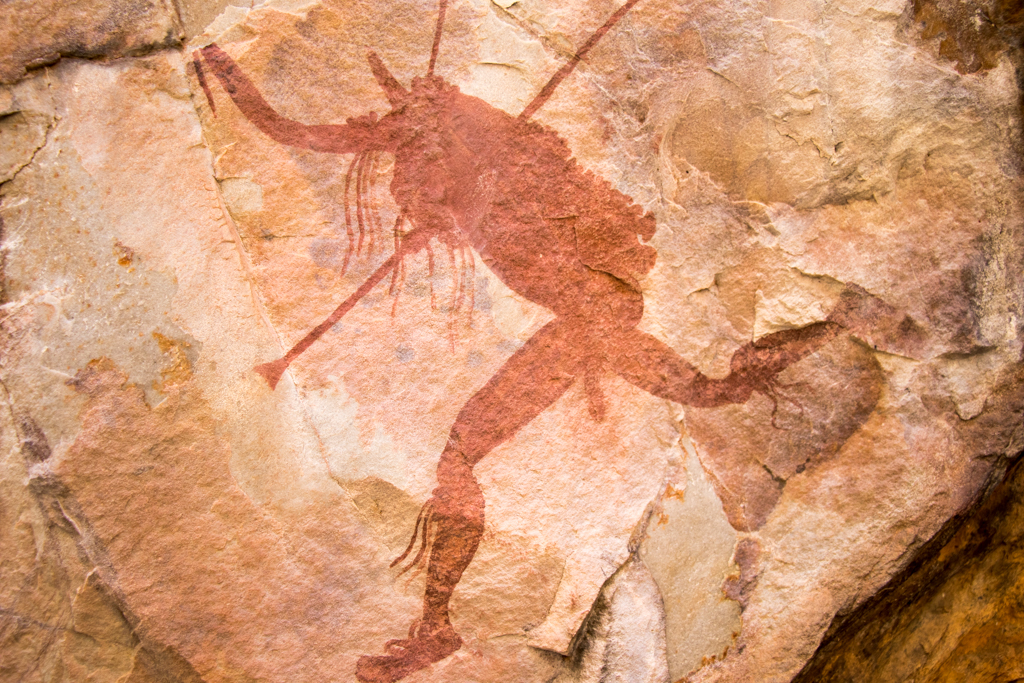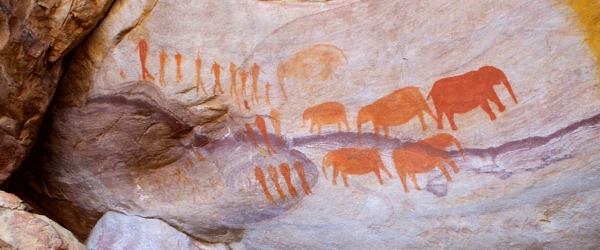Numerous studies have been done on southern African rock art, which is found in the southern African nations of Zimbabwe, South Africa, Lesotho, Swaziland, Mozambique, Botswana, and Namibia.
Many works of southern African rock art have been attributed to hunter-gatherer painters and engravers who appear to have had a shared set of cultural references due to perceived similarities in subject matter, even over considerable distances.
These have been connected to the beliefs and customs that still unite modern San Bushman people, a number of extant hunter-gatherer tribes that still reside mostly in Namibia, Botswana, and South Africa.
However, there are regional variations in both style and technique, and a number of rock art traditions are credited to different ethnic groups and their forebears.
Although it is challenging to determine the authorship, date, and motivation of rock art, this region’s rock art is still studied and has a wealth of information to share with us about its origins and the lives of the people who created it.
The physical conditions of southern Africa vary greatly, ranging from the Mozambican rainforest to the arid Namib Desert in western Namibia.
The climate tends to get drier as you move south and west. Southern Africa is home to both painted and etched rock art, with the nature and distribution being in part influenced by the geological features of the various locations.

Engraved rock art is typically found in inland locations with exposed boulders, flat rock ‘pavements,’ and rocky outcrops, whereas paintings are more frequently seen in mountainous or hilly places’ protective rock shelters.
Types of rock art
The hunter-gatherer style of rock art is arguably the most prevalent in southern Africa, with several examples known to exist in South Africa, Namibia, and Zimbabwe, as well as in Botswana and Mozambique.
This tradition uses engravings and paintings, both of which include both human and animal imagery. Area to region differs in kind and composition.
For instance, the southern Drakensberg and Maloti mountains in South Africa and Lesotho have more eland antelope photographs than Namibia, while the Maloti and Drakensberg mountains in Namibia have more giraffe images.
Regional differences can be seen in both style and color; for example, some locations and regions have polychrome (multicolored) paintings, while others do not.
Also read: From Captivity to Freedom, the Story of the Oromo Slaves from Ethiopia to South Africa
Paintings are more likely to have several pictures on a single surface, frequently interacting with one another, whereas engraving sites are more likely to have isolated images on individual rocks and boulders.
These compositional differences can also be seen between painting and engraving sites. There are, however, similarities in both imagery and style, with paintings all over southern Africa frequently featuring people in procession and carrying objects like bows and arrows.
Animals are another prominent theme in both paintings and engravings, particularly huge ungulates that are frequently and occasionally in great detail shown in a naturalistic manner.
Images may also contain individuals and animals that are more difficult to recognize since they seem to have characteristics of numerous different species.

In the Drakensberg-Maloti and Cape Fold Mountains in South Africa and Lesotho, the Brandberg and Erongo Mountains in Namibia, and the Matobo Hills in Zimbabwe, there are particularly high concentrations of hunter-gatherer rock paintings.
In contrast, engraving sites can be found all over the interior, frequently close to waterways.
The “late whites” produced a separate style of hunter-gatherer rock art, which is primarily found in the north-eastern region of southern Africa.
The reason that paintings in this tradition are known by this name is because they are frequently connected to the Iron Age farming communities that spoke Bantu languages and arrived in the region from the north around 2,000 years ago.
Many of these images are believed to have been created later than some of the older hunter-gatherer paintings.
Sometimes “late white” art depicts objects and scenes that could only have existed after European arrival, such as railroads, or they relate to dateable events.
European people and items are also depicted in other types of southern African rock art.
These include painted and engraved depictions of individuals riding horses while carrying weapons from all across South Africa.
As well as representations of a sailing ship from the Western Cape in South Africa that are thought to have been made after the mid-17th century.
These pictures are frequently called “contact art” since they depict the time of the first interaction between Europeans and native people.
These images come in a range of styles, and some of the people responsible for creating “contact” images in the Cape may have had Khoekhoen ancestry.
The Khoekhoen were formerly cattle and sheep herders; they shared a cultural heritage with the present Nama people and, in a less direct way, with the San|Bushman hunter-gatherers.
According to certain theories, the Khoekhoen people have a unique legacy of rock art. The engravings in this type are frequently discovered close to watercourses, and they are primarily geometric in form, with an emphasis on circular and dotted motifs.
History of research
The Bishop of Mozambique is thought to have been the first person to report seeing African rock art outside of the continent when he informed Lisbon’s Royal Academy of History in 1721 that he had seen paintings on rocks.
Following this, officials and explorers began to report, copy, and publish rock art from all around contemporary South Africa more often.
Rock art from modern-day Namibia, Zimbabwe, and Botswana started to be documented in the middle of the 19th century.
In the early 20th century, a number of illustrated books sparked a global public interest in the art.
According to reports, photographs, and copied images, hunter-gatherer rock art in particular had a strong aesthetic and academic appeal to western audiences.
This drew the attention of notable archaeologists and ethnologists like Miles Burkitt, Leo Frobenius, and Abbé Breuil, researchers whose interest in rock art around the world allowed them to visit and write about southern African rock art sites.
In the 1950s to 1970s, anthropological and archaeological research and documentation were significantly increased, and this led to new understandings on the interpretations and attributions of southern African rock art.
Today, rock art study is ongoing in the region.
It is now generally understood that hunter-gatherer art in southern Africa depicts symbols and motifs of spiritual and cultural significance.
As oopposed to depicting scenes from everyday life as was originally thought.
In particular, it’s believed that certain pictures depict trance visions of San|Bushman spiritual authorities, or shamans, during which they’re assumed to enter the world of spirits and are then held there to carry out responsibilities for themselves and their community, like healing the ill or causing rain.
This explanation, which has gained widespread acceptance, explains several aspects of the artwork, such as the preponderance of specific animals like the indigenous antelope.
Even though assigning dates to rock art is usually challenging, research on rock art sites in southern Africa has benefited from archaeological investigation, and excavations at rock art sites have occasionally turned up evidence that is helpful for doing so.
The Apollo 11 Cave painted plaques in Namibia, which have been dated to somewhere between 30,000 and 40,000 years ago, are arguably the most well-known examples of the earliest securely dated rock art in the world to have been discovered.
In Zimbabwe, painted spalls from shelter walls have been dated to 12,000 years ago or earlier, while a piece of an engraved animal discovered in South Africa’s Northern Cape is thought to be 10,200 years old or older.
The majority of the rock art that is still present, nevertheless, is assumed to have been created more recently.
Subject matter is once again useful in assigning maximum date ranges. For instance, we are aware that domestic animal depictions are most likely little older than 2,000 years.
Particularly with regard to engravings, which may occasionally be classified by the discoloration of the patina that darkens them through time, the condition of the art may also aid in establishing relative ages.
A significant part of southern Africa’s archaeological record is the abundance of rock art sites, which provide a wealth of information about former occupants’ lives and, in certain cases, continue to have religious and cultural significance for modern groups.
Numerous locations are accessible to the general public, giving visitors the chance to examine rock art in its natural setting.
Unfortunately, because it is in the open, rock art in the field is vulnerable to vandalism and environmental deterioration.
The Maloti-Drakensberg Park in South Africa and Lesotho, Twyfelfontein/Ui-Ais in Namibia, Tsodilo Hills in Botswana, and the Matobo Hills in Zimbabwe are all listed on the UNESCO World Heritage list.
Many significant rock art sites in southern Africa are also legally protected in their respective nations.

